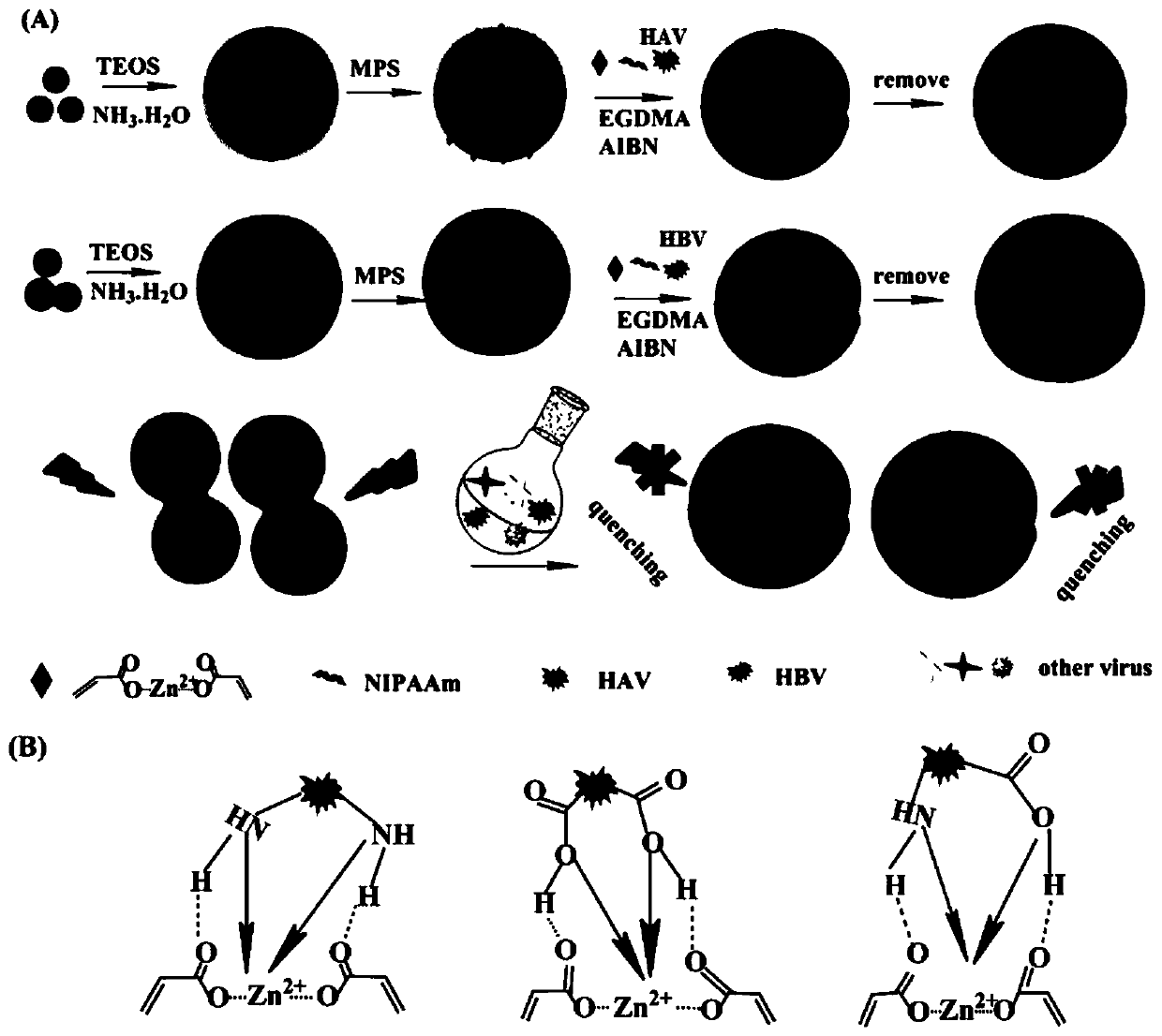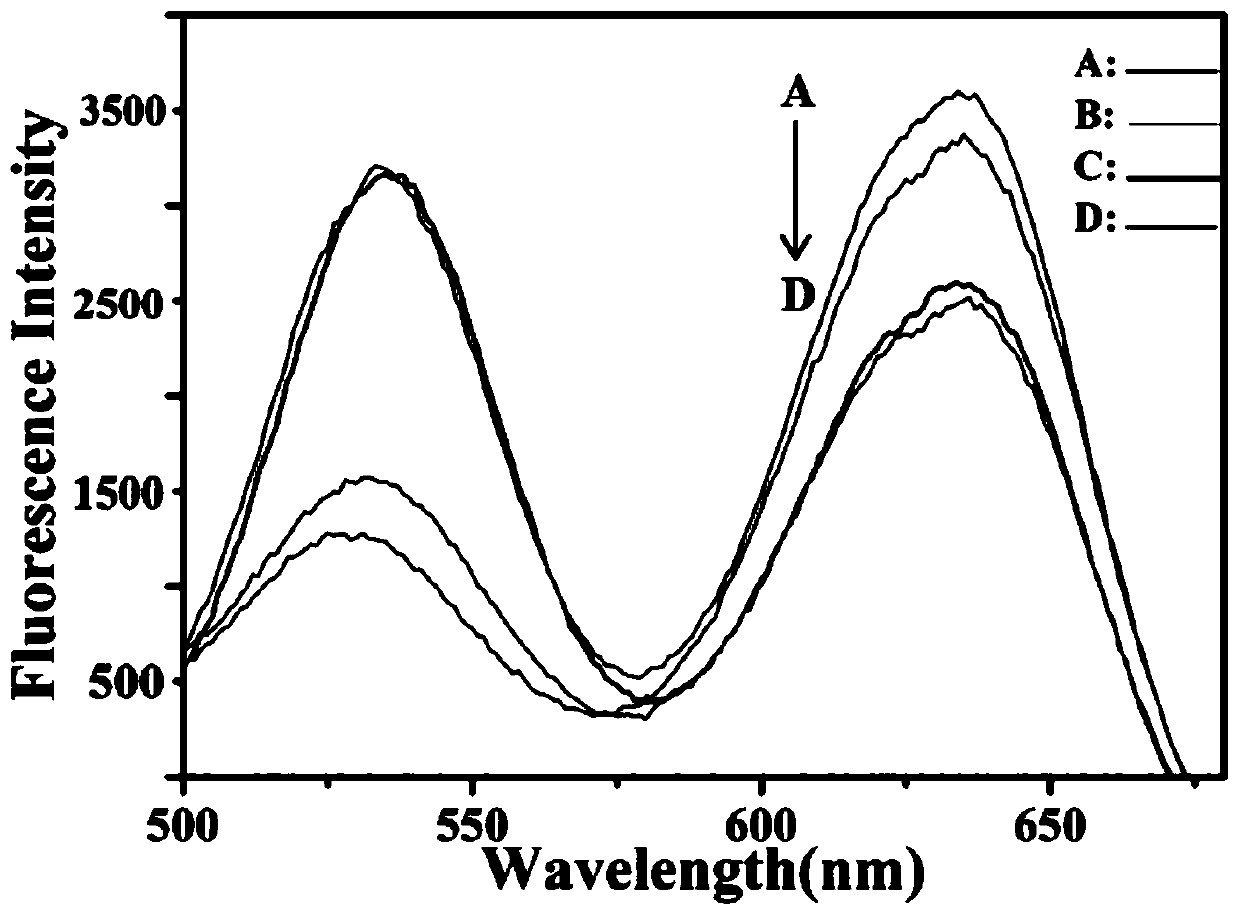Preparation method and application of molecularly imprinted fluorescence sensor for detecting two types of viruses simultaneously and visually
A fluorescent sensor and molecular imprinting technology, applied in the field of analytical chemical detection, can solve problems such as simultaneous detection of similar viruses and difficulty in imprinting, and achieve the effect of visual detection
- Summary
- Abstract
- Description
- Claims
- Application Information
AI Technical Summary
Problems solved by technology
Method used
Image
Examples
Embodiment 1
[0031] Example 1: A method for preparing a molecularly imprinted fluorescent sensor for simultaneous visual detection of two viruses
[0032] (1) Preparation of CdTe QDs: Mix 38.3mg tellurium powder with 40mg NaBH 4 Add it to a mixed solution of absolute ethanol (1.0 mL) and ultrapure water (1.0 mL), and react under nitrogen protection to obtain the NaHTe intermediate. 92.4mg Cd(NO 3 ) 2 2.5H 2 O and 63 μL of mercaptopropionic acid (MPA) were dissolved in 75 mL of ultrapure water, and the resulting solution was adjusted to a pH of 9.0–10.0 with NaOH (1.0 M), and dissolved oxygen was removed by nitrogen blowing. Subsequently, 1 mL of NaHTe solution was added to the above solution, refluxed at 100 °C for 1.5 h to obtain G-QDs, and refluxed for 30 h to obtain R-QDs.
[0033] (2)G-CdTe@SiO 2 and R-CdTe@SiO 2 Preparation: Add 5 mL of G-QDs (R-QDs) into 40 mL of ethanol, then add 20 μL of 3-aminopropyltriethoxysilane (APTES) and stir for 12 h, then, dropwise add 300 μL of tetrae...
Embodiment 2
[0037] Example 2: Characterization of the performance, morphology and structure of the G-MIPs / R-MIPs fluorescent sensor and intermediate products.
[0038] The structure and morphology of all the prepared materials were characterized by Fourier transform infrared spectrometer, potentiometer and scanning electron microscope. image 3 (A) is G-CdTe(a), G-CdTe@SiO 2 (b), G-CdTe@SiO 2 C=C(c), G-MIP(d)G-NIP; (B) is R-CdTe(a), R-CdTe@SiO 2 (b), R-CdTe@SiO 2 C=C(c), R-MIP(d) IR spectra of R-NIP particles. The absorption peaks of G-QDs and R-QDs appear at 1537-1555cm, respectively -1 , 1390-1398cm -1 Office; 1037-1043cm -1 is the stretching vibration peak of Si-O-Si, 786 cm -1 is the bending vibration peak of Si-O-Si, so it proves that the silica ground is coated on the quantum dot; the 1720-1728cm that appears after the template is eluted -1 The peaks are attributed to C=O stretching vibrations in zinc acrylate; NIPs show no significant difference compared to MIPs, indicati...
Embodiment 3
[0041] Example 3: Application of the G-MIPs / R-MIPs fluorescence sensor.
[0042] The experimental conditions of this example are: the mass ratio of G-MIPs to R-MIPs is 1:1.5, the dosage of G-MIPs and R-MIPs is 10 mg / mL, the pH is 7.5, the adsorption time is 20 min, and the temperature is 25°C. The specific implementation method is: take specific concentrations of HAV and HBV and add them to a 10 mg / mL mixed solution of G-MIPs and R-MIPs, adjust the pH of the entire system to 7.5, and measure the fluorescence intensity after shaking and adsorbing at 25°C for 20 minutes .
[0043] (1) Simultaneous detection and analysis of different concentrations of HAV and HBV by G-MIPs / R-MIPs fluorescent sensor
[0044] According to the above experimental steps, the HAV and HBV mixed solutions of different concentrations are detected and analyzed with the G-MIPs / R-MIPs fluorescent sensor of the present invention, the results are as follows Figure 6 As shown, the prepared sensor has an anal...
PUM
 Login to View More
Login to View More Abstract
Description
Claims
Application Information
 Login to View More
Login to View More - R&D
- Intellectual Property
- Life Sciences
- Materials
- Tech Scout
- Unparalleled Data Quality
- Higher Quality Content
- 60% Fewer Hallucinations
Browse by: Latest US Patents, China's latest patents, Technical Efficacy Thesaurus, Application Domain, Technology Topic, Popular Technical Reports.
© 2025 PatSnap. All rights reserved.Legal|Privacy policy|Modern Slavery Act Transparency Statement|Sitemap|About US| Contact US: help@patsnap.com



